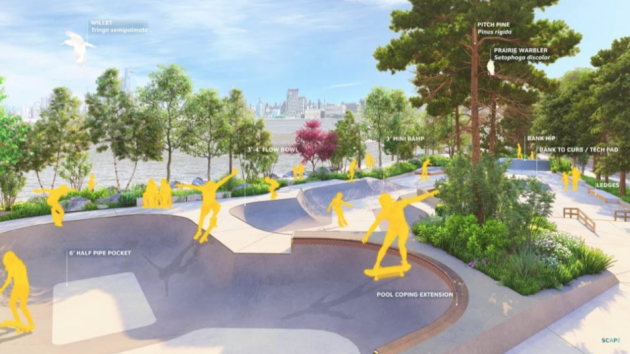The City of Hoboken has unveiled the first engineering designs of Maritime Park Phase I, which includes a new skate park, public plaza, living shoreline, and more.

By John Heinis/Hudson County View
“With these new design renderings, we are finally able to see the transformation of a former industrial site into a beautiful waterfront park for all to enjoy,” Mayor Ravi Bhalla said in a statement.
“I’m thrilled that this first phase includes brand new skate features, and its seamless integration into the rest of the waterfront park. When complete, this park will not only provide key amenities to the public including its active features but will also further our commitment to environmental stewardship. I look forward to seeing Maritime Park come to life as a centerpiece of our waterfront!”
The engineering designs were created following a comprehensive public planning
process which included online surveys, public meetings, a skatepark public engagement session, and more.
Based on community feedback from an in-person skatepark meeting and over 250 survey respondents, 63 percent of whom identified as skateboarders, the skatepark will include features that cater to skaters of all skill levels.
That will be done by including, six-foot half pipe pocket, three- to four-foot flow bowl, mini ramp, three-foot mini ramp, beginner-friendly ledges, a Euro-gap, flat rail, four stair with handrail, and tech pad, among other features.
Maritime Park Phase I will also include a living shoreline of natural marshes and tide pools that will be accessed through a step-down feature called the “Hudson Step Down” allowing for educational opportunities and additional seating.
Shoreline components will include rock sills, and seawalls, as well as wave attenuation structures to minimize the effects of erosion and allow for transitional uplands with native plantings that will restore the biodiversity and ecology of the area.
The new habitats are anticipated to attract a variety of species like Atlantic mud crab, monarch butterfly, snowy egret, marsh wren, piping plover, western honeybee, great blue heron, blue crab, fish species like the Atlantic silverside, and filter feeders like ribbed mussels that will also contribute to the overall health of the ecosystem by promoting nutrient cycling and water filtration.
The first phase plans, created by a team of consultants, including SCAPE, Colliers Engineering & Design, Action Sports Design, will also integrate a learning nursery and tree staging area to grow native plantings which will be used for later phases of the park’s
buildout to ensure plants acclimate to the site.
Additionally, a public plaza will be constructed near the skatepark made of natural materials and landscaping reminiscent of the topography and ecology of the Palisade cliffs.
The plaza will incorporate seating, shade structures, a water fountain, and prominent park signage welcoming visitors to Maritime Park.
The entire Maritime Park site, formerly a working dry dock, is about 8.7 acres in size, including 4.5 acres of land and 4.2 acres of water.
Hoboken officials announced the acquisition of the site in December 2022 in one of the most consequential land transactions in the City’s history, allowing Hoboken to connect one of the final pieces of the waterfront for public use.
The final concept envisions recreational spaces, including a large flexible lawn, the upgraded and enlarged skatepark, an expanded beach with a new Learning Pier for marine education, and a play area featuring natural materials and structures.
The Hudson River Waterfront Walkway would also be extended along the river’s edge to complete the final segment of Hoboken’s waterfront, and the park would also include a community building with public meeting space, and more.
Maritime Park will also integrate resiliency features including on-site stormwater management through rain gardens and bioswales, and a robust tree canopy to reduce the impacts of the urban heat island effect – as as considering rising sea levels.
The city will seek to bid and award a construction contract for Phase I by the fall of 2025.